A Special Sort of Place
Sunday 16 April
- Monday 17 April 2000;
Friday 21 April
– Sunday 30 April 2000
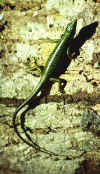 Yap
was one of the first islands we had highlighted as a must-see in Micronesia. Renowned as the land of giant stone money, it struck us as
being Micronesia’s most traditional island state and, always intrigued by
distinctive cultures and traditions, we were keen to experience for ourselves
this unique corner of the world.
Yap
was one of the first islands we had highlighted as a must-see in Micronesia. Renowned as the land of giant stone money, it struck us as
being Micronesia’s most traditional island state and, always intrigued by
distinctive cultures and traditions, we were keen to experience for ourselves
this unique corner of the world.
Different it certainly is.
From the moment we stepped off the airplane, we realized we were in a
different world. The women wore beautifully woven and brightly coloured lava
lava skirts and the men loin cloths. Everyone
from the customs official to the taxi driver looked as if they had a huge piece
of bubble-gum stuffed in their cheek. Often they would spit bright red
saliva, and when they smiled, which they often did, their teeth were stained a
brilliant crimson. Men and
women alike carried small woven baskets under their arms, and no-one was in a hurry to get anything done or go anywhere. In fact, the only people doing any kind of hustling,
bustling, pushing or shoving were the tourists!
As we reached the town center,
several local ladies were sitting outside the small supermarket in the center of
town, chatting. They were dressed
in lava lavas, flip-flops and, in true Yapese tradition, nothing else.
As cosmopolitan as we have become on our travels, we have to admit that
perhaps the most unusual situation we have ever found ourselves in is coming
face to face with topless ladies while wandering down the main aisle of a
supermarket. Having said that,
within a matter of hours we got over it, and it seemed the most natural thing in
the world (although not so natural that Pippa was ever inclined to go native).
The other sight we were to get
used to in a very short space of time was that of people preparing and chewing
the ubiquitous betel nut. Everyone
but everyone in Yap seems to chew buw, from first thing in the morning to
last thing at night. Betel nut
trees are found across the island, but demand here is so high that the nuts are
shipped in from other islands across Micronesia and sold in small Ziploc bags in
the supermarket for an extortionate $2.50 each.
Watching people prepare a betel nut for chewing is intriguing; it seems that an inordinate amount of care and precision is required
in preparation. First, the green
betel nut is split open, then sprinkled with a dry white powder (dry coral lime, used to stimulate the flow of saliva), and finally
wrapped in pepper leaves before being popped in the mouth and chewed. Sometimes tobacco is added for an additional zing.
When the betel nut is finished (how long it lasts depends on how
frequently one chews), the bright red remnants are spat out and the whole process begins
again. Delightful!
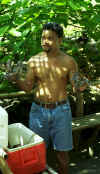 We
had two days to kill in Yap before heading out to the outer island of Fais, so
spent the time exploring Colonia and acquainting ourselves with the geographic
layout of Yap itself. Upon our return from Fais, we started to plan out
the remaining week or so we had in Yap, keen to fit in as much as we possibly
could before heading on to Palau. The
first highlight was a barbecue, hosted by Denitha for all the Fais islanders and
their families now living on the main island.
As adopted members of the Fais community, we were delighted to be invited
and spent the most wonderful day meeting new friends, learning more about Yapese
culture and understanding how life for the islanders has changed over the past
few decades.
We
had two days to kill in Yap before heading out to the outer island of Fais, so
spent the time exploring Colonia and acquainting ourselves with the geographic
layout of Yap itself. Upon our return from Fais, we started to plan out
the remaining week or so we had in Yap, keen to fit in as much as we possibly
could before heading on to Palau. The
first highlight was a barbecue, hosted by Denitha for all the Fais islanders and
their families now living on the main island.
As adopted members of the Fais community, we were delighted to be invited
and spent the most wonderful day meeting new friends, learning more about Yapese
culture and understanding how life for the islanders has changed over the past
few decades.
It was also the first
opportunity we had had to see what lay beyond the capitol of Colonia.
We drove with Sophiano to the northern-most part of the
island of Maap, passing through the island of Tomil-Gagil on the way and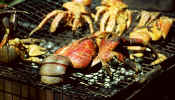 discovered that unlike the volcanic islands, Yap’s interior consisted of
gently rolling hills and scrub meadows. Inspired
by the varied scenery, we decided that we would have to hire a car if we wanted
to explore the island fully. The
location for the barbecue was stunning: a shady picnic area situated on a
small cliff overlooking the sea. There
were wooden benches and tables and a shelter built with traditional materials
such as bamboo, rope and thatch, and a small flight of steps leading down to a
most picturesque beach: white sand, palm trees and crystal clear water
stretching out at least a quarter-mile to the barrier reef, marked by white
breakers and a deep, dark blue sea beyond.
discovered that unlike the volcanic islands, Yap’s interior consisted of
gently rolling hills and scrub meadows. Inspired
by the varied scenery, we decided that we would have to hire a car if we wanted
to explore the island fully. The
location for the barbecue was stunning: a shady picnic area situated on a
small cliff overlooking the sea. There
were wooden benches and tables and a shelter built with traditional materials
such as bamboo, rope and thatch, and a small flight of steps leading down to a
most picturesque beach: white sand, palm trees and crystal clear water
stretching out at least a quarter-mile to the barrier reef, marked by white
breakers and a deep, dark blue sea beyond.
 The
coconut crabs Denitha had been given as we left Fais two days previously
reappeared and under the supervision of Sophiano, were cooked (live!) over the
barbecue, an old oil drum cut in half lengthways.
As truck loads of people
The
coconut crabs Denitha had been given as we left Fais two days previously
reappeared and under the supervision of Sophiano, were cooked (live!) over the
barbecue, an old oil drum cut in half lengthways.
As truck loads of people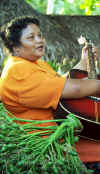 arrived, so did the food: chicken legs, sausages, salads, taro and
desserts
enough to feed an army. It was the
most relaxing, happy and magical time. The
men sat drinking cans of cold Budweiser on a small platform overlooking the
beach and put the world to rights while the children played and swam and the
women laid out the food and chatted. As the sun began to set, Denitha provided music,
strumming on her guitar and remembering old Chuukese songs from her childhood.
There was dancing and much merriment all round.
It was the kind of day that memories are made of, and the friendships we
formed and the fun we had will remain with us always.
arrived, so did the food: chicken legs, sausages, salads, taro and
desserts
enough to feed an army. It was the
most relaxing, happy and magical time. The
men sat drinking cans of cold Budweiser on a small platform overlooking the
beach and put the world to rights while the children played and swam and the
women laid out the food and chatted. As the sun began to set, Denitha provided music,
strumming on her guitar and remembering old Chuukese songs from her childhood.
There was dancing and much merriment all round.
It was the kind of day that memories are made of, and the friendships we
formed and the fun we had will remain with us always.
The day after the barbecue was
Easter Sunday. We had intended to
rise early to make it for the 04.00am Mass, but tired from the night before slept
right through our alarm. As we ate
breakfast outdoors at our hotel, we watched an Easter parade passing through the
town and once again realized how important a part religion played in people’s
daily lives here. It was a bright
sunny day so we set out to drive around the southern part of Yap island and
peruse the stone money for which this island was famous.
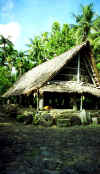 Beyond
Colonia, village life seemed to epitomize the essence of Yap island.
The main road around the island bypasses most of the villages so to reach
them we had to turn off onto the smaller lanes or park the car and walk.
Often we would find ourselves on the old stone footpaths that had been
built in centuries gone by and were well shaded by coconut palms, pandanus trees
and banana fronds. It felt as if we
were walking through a tunnel of greenery and travelling back in time. Suddenly we would come to a village, sparsely populated and
so quiet and peaceful we wondered if it had been deserted.
There would almost always be a traditional faluw (men’s house)
or pebai (community house), a large thatched structure built from
traditional materials (wood, bamboo, thatch and rope) with a sharply pitched
roof, supported by heavy wooden pillars and resting atop a stone platform.
And, of course, plenty of examples of rai (stone money).
Beyond
Colonia, village life seemed to epitomize the essence of Yap island.
The main road around the island bypasses most of the villages so to reach
them we had to turn off onto the smaller lanes or park the car and walk.
Often we would find ourselves on the old stone footpaths that had been
built in centuries gone by and were well shaded by coconut palms, pandanus trees
and banana fronds. It felt as if we
were walking through a tunnel of greenery and travelling back in time. Suddenly we would come to a village, sparsely populated and
so quiet and peaceful we wondered if it had been deserted.
There would almost always be a traditional faluw (men’s house)
or pebai (community house), a large thatched structure built from
traditional materials (wood, bamboo, thatch and rope) with a sharply pitched
roof, supported by heavy wooden pillars and resting atop a stone platform.
And, of course, plenty of examples of rai (stone money).
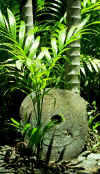 There
were many forms of indigenous money in Micronesia, some made of beads, others
from turtle shell or even rare clams. But
the most notable was the stone money of Yap, quarried from hard crystalline
limestone in Palau’s rock islands and transported back to Yap in canoes. Each piece of money was made from a single piece of stone and
quarried into huge flat discs. They
could be anything up to 4 metres (12 feet) in diameter and 5 tons in weight, and were
carried using a pole that slotted through a hole that had been bored through the
centre of the stone disc, giving it the appearance of a gigantic wheel.
With such weighty cargo, entire expeditions that set out from Yap to
bring stone money back from Palau were often lost at sea during their return
voyage, and that is why the money was so valuable.
There
were many forms of indigenous money in Micronesia, some made of beads, others
from turtle shell or even rare clams. But
the most notable was the stone money of Yap, quarried from hard crystalline
limestone in Palau’s rock islands and transported back to Yap in canoes. Each piece of money was made from a single piece of stone and
quarried into huge flat discs. They
could be anything up to 4 metres (12 feet) in diameter and 5 tons in weight, and were
carried using a pole that slotted through a hole that had been bored through the
centre of the stone disc, giving it the appearance of a gigantic wheel.
With such weighty cargo, entire expeditions that set out from Yap to
bring stone money back from Palau were often lost at sea during their return
voyage, and that is why the money was so valuable.
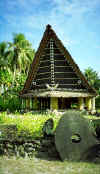 Today,
the pieces of stone money are still considered to hold great value and whole 'banks' of it can be seen lined up against the walls of the community houses
and throughout individual villages. Almost
all day-to-day transactions now involve cash, although we learned that land is
still sometimes bought and sold using stone money.
Today,
the pieces of stone money are still considered to hold great value and whole 'banks' of it can be seen lined up against the walls of the community houses
and throughout individual villages. Almost
all day-to-day transactions now involve cash, although we learned that land is
still sometimes bought and sold using stone money.
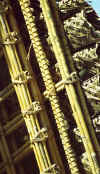 The
drive we took around the southern tip of Yap island was spectacular.
We came across a neat, tranquil village with some wonderful examples of
traditional houses, landscaped with stone money, hibiscus hedges and colourful,
variegated plants with bright, exotic flowers.
Much of the shoreline here was bordered with coconut palms and Yapese
mahogany trees, but slightly further west the coastline was studded with
mangroves, penny-sized red fiddler crabs scurrying about their roots.
The
drive we took around the southern tip of Yap island was spectacular.
We came across a neat, tranquil village with some wonderful examples of
traditional houses, landscaped with stone money, hibiscus hedges and colourful,
variegated plants with bright, exotic flowers.
Much of the shoreline here was bordered with coconut palms and Yapese
mahogany trees, but slightly further west the coastline was studded with
mangroves, penny-sized red fiddler crabs scurrying about their roots.
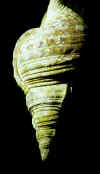 Further
north, we visited the village of Kadaay, a stunning, shady village reached along an old restored stone pathway, raised above fields of taro, banana
plants and betel nut trees and beneath the boughs of magnificent banyan trees. The meetinghouse here was beautiful, surrounded not only by
banks of stone money but also stone backrests, some of which had been carved.
They were bathed in a glorious dappled light that filtered through the
coconut palms overhead and gave the place a peacefulness and sense of
tranquility one rarely finds.
Further
north, we visited the village of Kadaay, a stunning, shady village reached along an old restored stone pathway, raised above fields of taro, banana
plants and betel nut trees and beneath the boughs of magnificent banyan trees. The meetinghouse here was beautiful, surrounded not only by
banks of stone money but also stone backrests, some of which had been carved.
They were bathed in a glorious dappled light that filtered through the
coconut palms overhead and gave the place a peacefulness and sense of
tranquility one rarely finds.
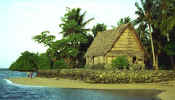 Wanting
to return to the place we'd had our barbecue, we drove north and found the village
of Bechiyal, situated at the water’s edge on the northern tip of Maap.
There was a small cultural centre here, and so peaceful was it that we
spent two nights camping out in a small hut adjacent to the beach, just a
stone's throw from its traditional pebai (the largest in Yap) and faluw
(the oldest). The snorkeling was
stunning: nursery fishes of all kinds including anemone fish and trigger fish,
as well as several sting rays which luckily seemed to be wary.
Wanting
to return to the place we'd had our barbecue, we drove north and found the village
of Bechiyal, situated at the water’s edge on the northern tip of Maap.
There was a small cultural centre here, and so peaceful was it that we
spent two nights camping out in a small hut adjacent to the beach, just a
stone's throw from its traditional pebai (the largest in Yap) and faluw
(the oldest). The snorkeling was
stunning: nursery fishes of all kinds including anemone fish and trigger fish,
as well as several sting rays which luckily seemed to be wary.
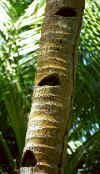 As
if all these new and varied discoveries were not enough, however, there was yet
more to explore on this incredible island, not least what lay beneath the ocean
waves further out to sea. And so we
spent a day scuba-diving (well, Pippa did the snorkeling thing while Eric had
all the fun underwater), steering well clear of the Manta Ray hot spot where all
the dive boats seemed to accumulate day after day.
The dives were wonderful and different: everything from sharks to
turtles, stingrays to sand pipers and caverns to coral.
Pippa also took her first foray into deep-sea fishing (something she was
to enjoy and insist we repeat later in the Solomon Islands) and we spent a day
out on the water trolling and casting with great success!
Dinner that night was fresh yellowfin tuna, with plenty extra for the
guys at the dive shop and their families as well as our hotel staff.
As
if all these new and varied discoveries were not enough, however, there was yet
more to explore on this incredible island, not least what lay beneath the ocean
waves further out to sea. And so we
spent a day scuba-diving (well, Pippa did the snorkeling thing while Eric had
all the fun underwater), steering well clear of the Manta Ray hot spot where all
the dive boats seemed to accumulate day after day.
The dives were wonderful and different: everything from sharks to
turtles, stingrays to sand pipers and caverns to coral.
Pippa also took her first foray into deep-sea fishing (something she was
to enjoy and insist we repeat later in the Solomon Islands) and we spent a day
out on the water trolling and casting with great success!
Dinner that night was fresh yellowfin tuna, with plenty extra for the
guys at the dive shop and their families as well as our hotel staff.
To round off our cultural
experience in Yap, we asked Sophiano if he would help us arrange a homestay with
a family somewhere on the island so we could have a chance to meet some more
local people and learn more about their ways of life.
He put us in touch with Theo and Antonia Thinnifel and their children
with whom we spent two pleasant days chatting, playing basketball and eating to
our hearts content. We shall always
have fond memories of the time we spent with them but as if memories were not
enough, they offered us gifts of coconut rope and machis (traditional
weavings made from hibiscus) to bring home with us and keep as souvenirs of the
most enchanting country we have visited on all our travels to date.
We were sad to leave when
finally the day came. Theo and
Antonia came to the airport to say goodbye, and brought Pippa a garland to wear
as a reminder of the warm hospitality we had received during our stay.
We learnt many sayings during our time in Yap and to this day quote some
of them. Among our favorites are:
“It takes a village to raise a child”; “The wisdom is in the bag” (a
reference to their betel nut baskets) and “What’s yours is mine, what’s
mine is yours”. But perhaps the
best summary of the island was a quote from a tourist brochure:
“It takes patience, good
manners and plenty of understanding to see Yap and observe its many traditions.
Yap is not a world built for tourists but a world that welcomes
visitors.”